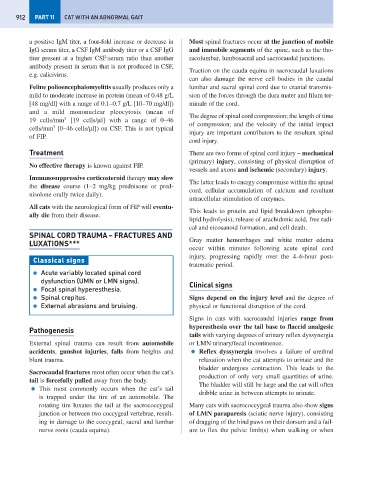Page 920 - Problem-Based Feline Medicine
P. 920
912 PART 11 CAT WITH AN ABNORMAL GAIT
a positive IgM titer, a four-fold increase or decrease in Most spinal fractures occur at the junction of mobile
IgG serum titer, a CSF IgM antibody titer or a CSF IgG and immobile segments of the spine, such as the tho-
titer present at a higher CSF:serum ratio than another racolumbar, lumbosacral and sacrocaudal junctions.
antibody present in serum that is not produced in CSF,
Traction on the cauda equina in sacrocaudal luxations
e.g. calicivirus.
can also damage the nerve cell bodies in the caudal
Feline polioencephalomyelitis usually produces only a lumbar and sacral spinal cord due to cranial transmis-
mild to moderate increase in protein (mean of 0.48 g/L sion of the forces through the dura mater and filum ter-
[48 mg/dl] with a range of 0.1–0.7 g/L [10–70 mg/dl]) minale of the cord.
and a mild mononuclear pleocytosis (mean of
The degree of spinal cord compression; the length of time
3
19 cells/mm [19 cells/μl] with a range of 0–46
of compression; and the velocity of the initial impact
3
cells/mm [0–46 cells/μl]) on CSF. This is not typical
injury are important contributors to the resultant spinal
of FIP.
cord injury.
Treatment There are two forms of spinal cord injury – mechanical
(primary) injury, consisting of physical disruption of
No effective therapy is known against FIP.
vessels and axons and ischemic (secondary) injury.
Immunosuppressive corticosteroid therapy may slow
The latter leads to energy compromise within the spinal
the disease course (1–2 mg/kg prednisone or pred-
cord, cellular accumulation of calcium and resultant
nisolone orally twice daily).
intracellular stimulation of enzymes.
All cats with the neurological form of FIP will eventu-
This leads to protein and lipid breakdown (phospho-
ally die from their disease.
lipid hydrolysis), release of arachidonic acid, free radi-
cal and eicosanoid formation, and cell death.
SPINAL CORD TRAUMA – FRACTURES AND
Gray matter hemorrhages and white matter edema
LUXATIONS***
occur within minutes following acute spinal cord
injury, progressing rapidly over the 4–6-hour post-
Classical signs
traumatic period.
● Acute variably located spinal cord
dysfunction (UMN or LMN signs).
Clinical signs
● Focal spinal hyperesthesia.
● Spinal crepitus. Signs depend on the injury level and the degree of
● External abrasions and bruising. physical or functional disruption of the cord.
Signs in cats with sacrocaudal injuries range from
hyperesthesia over the tail base to flaccid analgesic
Pathogenesis
tails with varying degrees of urinary reflex dyssynergia
External spinal trauma can result from automobile or LMN urinary/fecal incontinence.
accidents, gunshot injuries, falls from heights and ● Reflex dyssynergia involves a failure of urethral
blunt trauma. relaxation when the cat attempts to urinate and the
bladder undergoes contraction. This leads to the
Sacrocaudal fractures most often occur when the cat’s
production of only very small quantities of urine.
tail is forcefully pulled away from the body.
The bladder will still be large and the cat will often
● This most commonly occurs when the cat’s tail
dribble urine in between attempts to urinate.
is trapped under the tire of an automobile. The
rotating tire luxates the tail at the sacrococcygeal Many cats with sacrococcygeal trauma also show signs
junction or between two coccygeal vertebrae, result- of LMN paraparesis (sciatic nerve injury), consisting
ing in damage to the coccygeal, sacral and lumbar of dragging of the hind paws on their dorsum and a fail-
nerve roots (cauda equina). ure to flex the pelvic limb(s) when walking or when

